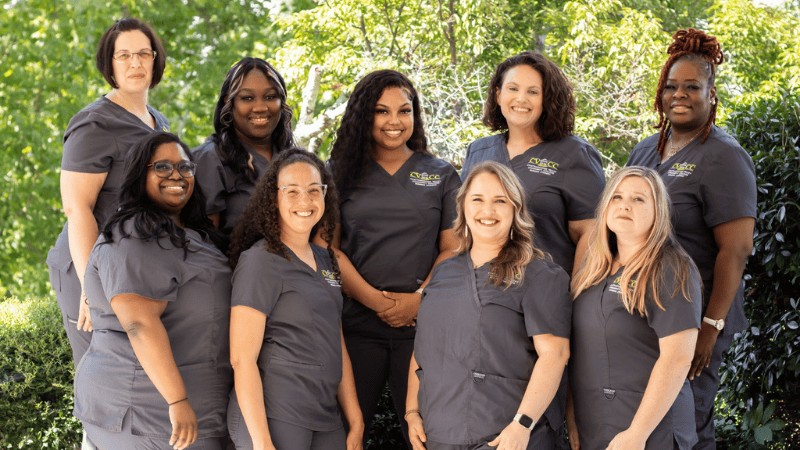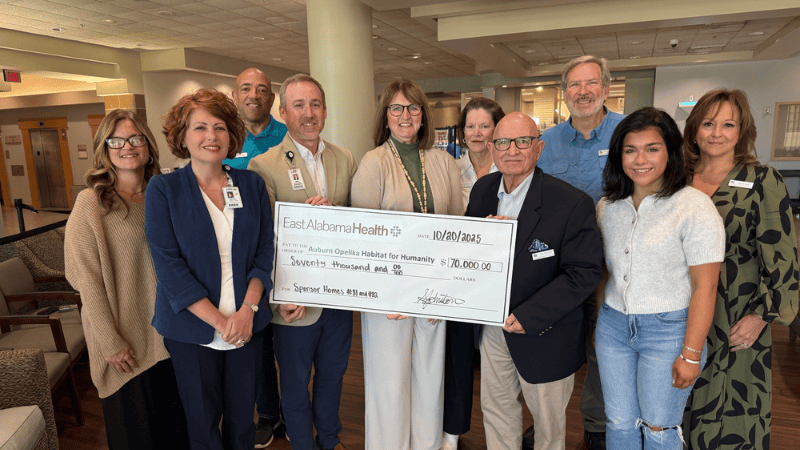Precision and Excellence: Four EAMC Surgeons Surpass 1,000+ Robotic Surgeries
June 30, 2025
Categories: Surgery
Tags: Robotic Surgery
In the operating rooms at East Alabama Medical Center (EAMC), four surgeons have quietly reached milestones that reflect their experience and commitment to patient care by surpassing 1,000 robotic-assisted procedures.
Their collective work has touched the lives of thousands of patients, helping them heal with fewer complications, smaller incisions and shorter hospital stays.
In the 15 years since the first robotic procedure was performed at EAMC, robotic surgeries have become an integral part of how East Alabama Health delivers high-quality, compassionate health care for patients across Alabama and Georgia.
Now, with the arrival of two new da Vinci 5 (DV5) systems, the latest robotic surgery system from Intuitive, the organization is building on its legacy of excellence. For Drs. Njideka Obiekwe, Allen Foster, Kerri Bevis and Wes Cutcliffe, this represents the next chapter in the work they have helped advance. Their journeys offer a glimpse into how surgical innovation becomes standard, one case at a time.
Njideka Obiekwe, M.D.
Njideka Obiekwe, M.D., is a champion for robotic procedures and the benefits they can have for patients. She serves as medical director of the robotics program at EAMC, and in 2022, she became the first physician at EAMC to complete 1,000 robotic procedures. At the time, she was just the third obstetrician/gynecologist in Alabama to have done so.
Dr. Obiekwe has helped lead the robotics effort at EAMC since the program’s infancy, having completed her first procedure in 2013.
As of June 2025, Dr. Obiekwe has completed nearly 1,500 robotic-assisted surgeries. For her, the benefits of robotic procedures for patients and surgeons are unmatched.
“For both surgeons and patients, the biggest advantage is quicker surgery, smaller incisions, less post-operative complications, precision and control during minimally invasive procedures,” Obiekwe stated. “Over 90 percent of my GYN surgeries are done robotically, including hysterectomies, cystectomies, oophorectomies, excision of pelvic endometriosis, tubal re-anastomosis and myomectomies.”
Dr. Obiekwe sees East Alabama Health’s robotics program continuing to expand and innovate, offering advanced surgical care to a broader range of patients.
“The future for robotic surgery is very bright, as each newer robot has new features that continue to make the experience for both patients and surgeons even better and will continue to evolve to include more specialties,” Obiekwe said. “Our newest addition, the da Vinci 5, has the capabilities for real time intra-operative consults, creating unique training opportunities for surgeons and surgeons-in-training.”
Allen Foster, M.D.
Allen Foster, M.D., specializes in general surgery and gastroenterological procedures and performs a range of minimally invasive procedures. He completed his first robotic procedure in 2014 and has since performed over 1,500 robotic-assisted surgeries.
A common fear among patients is that surgery will require a long recovery, meaning unwanted absences from work and social life. For Dr. Foster, one of the main advantages of minimally invasive procedures is the quick recovery times for patients.
“For patients, robotic procedures offer less pain and a quicker return to work and regular activities,” Foster said. “For surgeons, it offers better visualization of the procedure, offering us enhanced precision.”
Kerri Bevis, M.D.
Kerri Bevis, M.D., is a gynecologic oncologist who practices at the Spencer Cancer Center. She was initially drawn to gynecologic oncology because it is a rare specialty that allows for true comprehensive care of women with cancer and provides an opportunity for longitudinal care for patients over many years of their lives.
Dr. Bevis’ impact stretches beyond east Alabama, having treated patients from as far away as the Florida Panhandle. On Dec. 5, 2024, she became the third surgeon at EAMC to complete 1,000 robotic procedures.
Dr. Bevis describes robotic surgery as a breakthrough that enhances both the surgeon’s capabilities and the patient’s recovery experience.
“It allows the surgeon to use their hands in the way they were designed to be used, but the hands don’t actually have to go inside the body to do it—just think about that,” Dr. Bevis reflected. “For patients, bleeding, infection and post-operative pain are all reduced, and they are able to recover and return to life much faster, even from very complex surgeries. It’s truly remarkable.”
For Dr. Bevis, the real impact of robotic surgery lies in the ability to perform delicate procedures with consistency and precision, even in the most complex cases.
“The vision in my mind that is most vivid when I stop to consider robotic surgery is the consistency with which a surgeon can perform a very delicate procedure in a living and breathing person,” Dr. Bevis stated. “It truly does make surgery beautiful. You can see the tiniest structures so clearly with the camera’s magnification and high-definition optics and move the instruments so precisely and quite naturally that it just takes surgery to a new level.”
Dr. Bevis is also responsible for piloting Enhanced Recovery After Surgery (ERAS) at East Alabama Health.
ERAS is a multidisciplinary, evidence-based approach to perioperative care designed to reduce surgical stress, maintain physiological function and promote faster recovery. In essence, ERAS addresses the key factors that keep patients in the hospital after surgery and identifies ways to address those factors so patients can return to their normal routine.
Having performed robotic surgery since 2009—first using the da Vinci Si system, then the da Vinci Xi, and now the da Vinci 5—she has seen the technology evolve to better meet the needs of patients and physicians alike.
The new da Vinci 5’s force feedback sensors, which measure the push, pull and directional forces on the tip of the robot’s instruments nearly 1,000 times per second, are a major advancement according to Dr. Bevis.
“Now patients can have even safer surgeries because the surgeons can feel the tissue more effectively through the instruments which helps prevent excess tissue damage and the surgeon is much more comfortable during long operations” Dr. Bevis said.
Wes Cutcliffe, D.O.
Wes Cutcliffe, D.O., performed his 1,000th robotic procedure on Dec. 30, 2024. The journey began when he first arrived in the east Alabama region in 2019.
“When I came to East Alabama to start my career, I went to the da Vinci training center in Atlanta to get hands-on experience with the Xi system [the most recent da Vinci system prior to the DV5],” Dr. Cutcliffe said. “Intuitive also brought in experienced surgeons as well as on-site support for when we began more-advanced cases.
“I also learned a great deal from my senior partners who were a valuable resource early on as I was growing my practice.”
For Dr. Cutcliffe, robotic surgery provides a streamlined process that reduces complications during procedures. He points to the capabilities of the robots to reduce procedure times by providing a clearer image of the operating zone.
“Robotic surgery provides better visualization and more easily maneuverable instruments which allow surgeons to complete more-advanced cases in minimally invasive fashion,” Dr. Cutcliffe said. “This allows our patients to spend less time in the hospital and get back to their normal routines quicker.”
As of June 2025, Dr. Cutcliffe has cared for over 1,100 patients through robotically assisted procedures. With East Alabama Health’s acquisition of two new da Vinci 5 systems, Cutcliffe sees further enhancements during robotic procedures, providing patients with minimal scarring and a faster return to normal.
“I’m very excited about the newest generation of the robot,” Dr. Cutcliffe said. “It will provide better functionality for both the surgeons and OR staff, so we can continue providing state-of-the-art minimally invasive surgery to our community.”
-###-
About East Alabama Health
East Alabama Health encompasses East Alabama Medical Center in Opelika, EAMC-Lanier Rural Emergency Hospital in Valley, the Spencer Cancer Center in Opelika, the Auburn Medical Pavilion and a host of other key medical clinics and practices that help provide a continuum of care to patients throughout an 11-county area. EAMC is a 314-bed regional referral hospital that is currently under construction to add 30 critical care beds. EAMC-Lanier Rural Emergency Hospital provides emergency and outpatient services while its campus also features a nursing home and an ambulatory surgery center. East Alabama Health employs about 3,900 people and is the second largest employer in the region, trailing only Auburn University.


